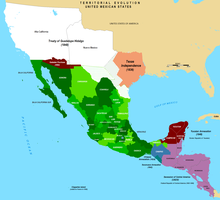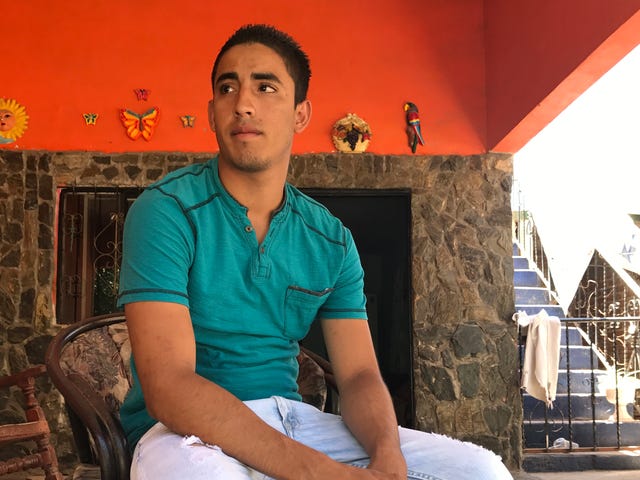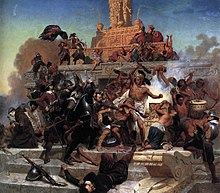When treason prospers, none dare care it treason, to summarize the old saying. But even to speak of “treason” raises a more fundamental question—treason against what? Under that old English law that some say it is now “racist” to evoke, it was once treason to “imagine” the death of the king, queen, or heir. For a wife to murder her husband was “petty treason.” Under almost every system, treason is punishable by death because it endangers not just citizens, but the very principles of authority and responsibility on which society rests. Thus, what a society considers “treason” tells us what that society values.
It’s therefore interesting that Jorge Ramos, the Mexican-born Spanish-language news anchor, is accusing Republicans of wanting the so-called “Dreamers” to commit something like treason.
Of course, what Republicans are asking of the “Dreamers” is to put their loyalty to this country—the country we are constantly (and inaccurately) told is the “only country they have ever known”—over the interests of foreigners. This is, after all, what any country would ask of those who want to immigrate. And yet Mr. Ramos’s reaction is an implicit admission that the propaganda line being used to argue for amnesty—that “Dreamers” are simply undocumented Americans—is false. To accuse Mr. Ramos and his ideological allies of “dual loyalty” would be to understate the case; he appears to have little loyalty to the United States at all.
“I finally recognized that I cannot be defined by one country. I am from both countries,” Mr. Ramos said of his decision not to return to Mexico despite dual citizenship. But this does not make him American. His continued attachment to Mexico means he has broken the oath he took to become a U.S. citizen, in which he swore, “I absolutely and entirely renounce and abjure all allegiance and fidelity to any foreign prince, potentate, state or sovereignty of whom or which I have heretofore have been a subject or citizen” and will “bear true faith and allegiance” to the United States.
The blue-eyed Mr. Ramos could easily be considered white—what Steve Sailer calls a “Conquistador-American.” However, he prefers to serve as a tribune for Hispanics, including the millions of non-white indigenous Latin Americans who are clumsily characterized as his fellow Hispanics. Mr. Ramos describes his television network as “pro-immigrant,” and speaks openly of his goal of increasing the power of his ethnic community in all aspects of American life. He is suspicious of the whites who built the society he credits with giving him “complete freedom of expression.” In his documentary, “Hate Rising,” he is incensed when those of us who are not dual citizens oppose the transformation of our country through mass immigration. He has also said that no journalist should maintain neutrality when reporting on Donald Trump.

Yet Mr. Ramos is fundamentally right when he complains that the United States is asking Hispanics to declare loyalty to law rather than to their blood and kin. Law is an abstraction, just like American citizenship, as Mr. Ramos’s indifferent attitude towards this country shows. Mr. Ramos puts ethnic identity above country, or, more accurately, above thiscountry. This is natural—but it is hypocritical for him to be outraged by European-Americans who see so-called “Dreamers” as alien occupiers.
Mr. Ramos’s own, stated position justifies that outrage. He says that no self-respecting Hispanic can permit immigration restrictions that could keep relatives out of this country.
This is a strong argument for a stopping immigration completely. Under Mr. Ramos’s logic, letting in one foreigner obligates us to let in his entire extended family. If blood loyalty requires that Hispanics put family immigration over respect for American law, each new Hispanic immigrant is essentially a traitor in waiting. If loyalty to La Raza is treason to America, we should not let in even one more Hispanic.
Mr. Ramos’s conception of blood loyalty is an interesting counterpoint to recent comments of the prospective Speaker of the House, Nancy Pelosi. Recently, she said she was proud that her six-year-old had wished on his birthday that he had brown skin and brown eyes like his best friend who is Guatemalan. She is clearly not concerned about an influx of Third Worlders.
At the same time, we get accusations of “treason” against President Trump and his family for supposed “collusion” with Russia. No evidence of such collusion has yet been produced, and as President Trump is increasing the size of the military, killing Russians in Syria, and generally continuing the anti-Russian position of American foreign policy, our Commander-in-Chief is hardly a Putin “puppet.” The vastly larger subversive efforts of China, whose entire society was recently described as a “threat” by the director of the FBI, pass all but unnoticed by the American media, as are Mexico’s clear efforts to influence American policy.
The Left and La Raza activists like Mr. Ramos seem to have no concern for the founding stock of the United States. The country appears to be nothing more than a vehicle for realizing their ambitions. Nancy Pelosi and her like do not seem to care whether people who look like them become a minority. As for Mr. Ramos, there is a frank element of conquest involved, as Mr. Ramos anticipates the United States becoming a Hispanic nation. In both cases, the core European-American population appears to be either an afterthought or an obstacle.
It’s only American conservatives who want to pretend there is no link between race and nation. For example, one Ken Oliver at Newsbusters faulted Jorge Ramos and Jared Taylor for “identity politics gone mad” which “only serves to divide Americans.” “In Jared Taylor’s America, as a white man he evidently cannot be adequately represented by a non-white,” he wrote, “nor in Jorge Ramos’s America can Ramos be adequately politically represented by a non-Hispanic.”
Yet these “Americans” Mr. Oliver posits are largely a fiction. Most Americans throughout this country’s history would have taken the link between American and white identity for granted. The American conservatives able to imagine a deracinated American identity are, like Mr. Oliver, almost all white. But many of the non-whites who are rapidly forming the new American majority prize their racial identity above any “American” identity, and it is hard to fault them for doing so.
In a real nation, there is no distinction between “my country” and “my people.” What remains of authentic American patriotism trades on the nostalgia from the time in American history when this was true. Leftists instinctively know this, which is why many denounce expressions of civic nationalism as “white nationalism.” Mr. Ramos also appears to feel that loyalty to America is treason to his fellow Hispanics.
For European-Americans—at least for those who can see what is at stake—the calculation is different. Loyalty to America means loyalty to whites. As the Founding Fathers understood, it means loyalty “to ourselves and to our posterity.” And it means calling advocacy for open borders what it is: a deliberate sacrifice of this country for the benefit of foreigners. As Peter Brimelow has said, the response to the accusation of racism is the charge of treason. Mr. Ramos’s own comments show this charge is accurate. He can be loyal to his fellow Hispanics or loyal to his citizenship oath, but not both. If he wants to be a champion of what he regards as his people, he can do it as an honest man in his own country, instead of subverting ours.
READ BELOW: THE UNITED STATES DOES NOT NEED TO BE LECTURED ABOUT MORALS BY ANY MEXICAN OFFICIAL, NOT TODAY, NOT TOMORROW, NOT EVER.
Prior to the Spanish Conquistadors conquering Mexico the country was under the hegemony of the Aztec empire. The Aztec of Central Mexico built a tributary empire covering most of central Mexico. The Aztec were noted for practicing human sacrifice on a large scale. Along with this practice, they avoided killing enemies on the battlefield. Their warring casualty rate was far lower than that of their Spanish counterparts, whose principal objective was immediate slaughter during battle. This distinct Mesoamerican cultural tradition of human sacrifice ended with the Spanish conquest in the 16th century. Over the next centuries Mexican indigenous cultures were gradually subjected to Spanish colonial rule. One could say that the Spanish were ruthless killas.
The Spanish first learned of Mexico during the Juan de Grijalva expedition of 1518. The Spanish conquest of the Aztec Empire began in February 1519 when Hernán Cortés arrived at the port in Veracruz with 500 conquistadores. After taking control of that city, he moved on to the Aztec capital. In his search for gold and other riches, Cortés decided to invade and conquer the Aztec empire.
When the Spaniards arrived, the ruler of the Aztec empire was Moctezuma II, who was later killed. His successor and brother Cuitláhuac took control of the Aztec empire, but was among the first to fall from the first smallpox epidemic in the area a short time later. Unintentionally introduced by Spanish conquerors, among whom smallpox was endemic, the infectious disease ravaged Mesoamerica in the 1520s. It killed more than 3 million natives as they had no immunity. Other sources, however, mentioned that the death toll of the Aztecs might have reached 15 million (out of a population of less than 30 million) although such a high number conflicts with the 350,000 Aztecs who ruled an empire of 5 million or 10 million. Severely weakened, the Aztec empire was easily defeated by Cortés and his forces on his second return with the help of state of Tlaxcala whose population estimate was 300,000. The native population declined 80–90% by 1600 to 1–2.5 million. Any population estimate of pre-Columbian Mexico is bound to be a guess but 8–12 million is often suggested for the area encompassed by the modern nation.
The deaths caused by smallpox are believed to have triggered a rapid growth of Christianity in Mexico and the Americas. At first, the Aztecs believed the epidemic was a punishment from an angry god, but they later accepted their fate and no longer resisted the Spanish rule. Many of the surviving Aztecs believed that smallpox could be credited to the superiority of the Christian god, which resulted in their acceptance of Catholicism and yielding to the Spanish rule throughout Mexico.
The territory became part of the Spanish Empire under the name of New Spain. Mexico City was systematically rebuilt by Cortés following the Fall of Tenochtitlan in 1521. Much of the identity, traditions and architecture of Mexico developed during the 300-year colonial period. The capture of Tenochtitlan and refounding of Mexico City in 1521, marked the beginning of a 300-year-long colonial era during which Mexico was known as Nueva España (New Spain). The Kingdom of New Spain was created from the remnants of the Aztec hegemonic empire. Subsequent enlargements, such as the conquest of the Tarascan state, resulted in the creation of the Viceroyalty of New Spain in 1535. The Viceroyalty at its greatest extent included the territories of modern Mexico, Central America as far south as Costa Rica, and the western United States. The territorial evolution of Mexico after independence, noting the secession of Central America (purple), Chiapas annexed from Guatemala (blue), losses to the US (red, white and orange) and the reannexation of the Republic of Yucatan (red).
The indigenous population stabilized around one to one and a half million individuals in the 17th century from the most commonly accepted five to ten million pre-contact population. The population decline was primarily the result of communicable diseases (particularly small pox) introduced during the Columbian Exchange. During the three hundred years of the colonial era, Mexico received some 400,000 to half a million Europeans, 200,000 to 250,000 Africans and 40,000 to 120,000 Asians. The 18th century saw a great increase in the percentage of mestizos (The Penguin Atlas of World Population History.
Agustín de Iturbide became constitutional emperor of the First Mexican Empire in 1822. A revolt against him in 1823 established the United Mexican States. In 1824, a Republican Constitution was drafted and Guadalupe Victoria became the first president of the newly born country. In 1829 president Guerrero abolished slavery. The first decades of the post-independence period were marked by economic instability, which led to the Pastry War in 1836. There was constant strife between liberales, supporters of a federal form of government, and conservadores, who proposed a hierarchical form of government.
During this period, the frontier borderlands to the north became quite isolated from the government in Mexico City, and its monopolistic economic policies caused suffering. With limited trade, the people had difficulty meeting tax payments and resented the central government’s actions in collecting customs. Resentment built up from California to Texas. Both the mission system and the presidios had collapsed after the Spanish withdrew from the colony, causing great disruption especially in Alta California and New Mexico. The people in the borderlands had to raise local militias to protect themselves from hostile Native Americans. These areas developed in different directions from the center of the country.
Wanting to stabilize and develop the frontier, Mexico encouraged immigration into present-day Texas, as they were unable to persuade people from central Mexico to move into those areas.They allowed for religious freedom for the new settlers, who were primarily Protestant English speakers from the United States. Within several years, the Anglos far outnumbered the Tejano in the area. Itinerant traders traveled through the area, working by free market principles. The Tejano grew more separate from the government and due to its neglect, many supported the idea of independence and joined movements to that end, collaborating with the English-speaking Americans.
General Antonio López de Santa Anna, a centralist and two-time dictator, approved the Siete Leyes in 1836, a radical amendment that institutionalized the centralized form of government. When he suspended the 1824 Constitution, civil war spread across the country. Three new governments declared independence: the Republic of Texas, the Republic of the Rio Grande and the Republic of Yucatán.
Second Republic and Second Empire (1846–1867)
The 1846 United States annexation of the Republic of Texas and subsequent American military incursion into territory that was part of Coahuila (also claimed by Texas) instigated the Mexican–American War. The war was settled in 1848 via the Treaty of Guadalupe Hidalgo. Mexico was forced to give up more than one-third of its land to the U.S., including Alta California, Santa Fe de Nuevo México and the territory claimed by Texas. A much smaller transfer of territory in what is today southern Arizona and southwestern New Mexico—known as the Gadsden Purchase—occurred in 1854.
The Caste War of Yucatán, the Maya uprising that began in 1847, was one of the most successful modern Native American revolts. Maya rebels, or Cruzob, maintained relatively independent enclaves in the peninsula until the 1930s.
So it be that the HISTORY OF MEXICO is one of conquest and revolt. The Spanish were red blooded killers, guilty today of mass murder and plunder. Their philosophy of conquest seeks no end. They are intent on Spanishizing the Estados Unidos. Until they conquer America their appetite will not be satisfied.
When Mexican President’s lectures us it is necessary to turn the tables on their Spanish Ancestor killing machine. Americans must and will stand up to this Spanish onslaught. The Latino/Hispanic mind knows no end, seeking to monopolize public opinion and blame White Americans for their lot in life. The European Caucasian is in no way responsible for their misery. Time to stand up and throw their violent colonial history back in their face.
BUILD THE WALL AND MAKE MEXICO PAY FOR IT. STOP THE ILLEGAL FROM ENTERING OUR GREAT COUNTRY









